The HTC One X for AT&T Review
by Brian Klug on May 1, 2012 6:00 PM EST- Posted in
- Smartphones
- Snapdragon
- HTC
- Qualcomm
- MSM8960
- Krait
- Mobile
- Tegra 3
- HTC One
- NVIDIA
Probably one of the biggest changes with the HTC One series is emphasis on camera quality. It’s quickly becoming one of the most important axes of both improvement and comparison for handset vendors, and HTC has taken a rather unique approach with the One. So what is that unique approach exactly? It’s the inclusion of discrete ISP which HTC calls ImageChip.
Moving to a discrete ISP to tackle some of the image pipeline makes sense for a number of reasons. First, it makes optimizing for image quality less of a moving target if you’re a handset vendor. Each SoC has different ISP, and each combination of both ISP and camera sensor/module needs to be tweaked for optimal image quality. The result is a lot of optimization work that takes time if you’re deploying multiple platforms with silicon from different vendors. Moving to one single controlled platform in conjunction with one single module and sensor makes it possible to really squeeze everything out of that combination, and in addition spend more time characterizing the system. The other axis ties into the One branding - each One series smartphone should actually perform the same, thanks to this unified combination of ISP and rear facing camera. So far, this applies to all of the One S and One X(L) variants.
HTC’s ImageChip is responsible for most of the things that would traditionally be done on the SoC ISP. 3A (Autofocus, Auto white balance, and Autoexposure), lens correction (geometric and chromatic correction), noise reduction, best shot selection, continuous auto focus, controlling gains on the CMOS sensor, LED flash level decision, region of interest identification (augmented with face detection) and so on. This is all stuff you can verify yourself by taking apart some of the ISP related files - curiously enough internally ImageChip is actually referred to as “rawchip.” This is also the hardware responsible for enabling HTC’s extremely fast image continuous capture and frame grabbing during video capture (HTC Video Pic). It’s somewhat analogous to what Google and TI did with the OMAP4460 on the Galaxy Nexus, except discrete and with a much more ambitious focus.
The rest of HTC’s efforts involve both optics and sensor. The optical system consists of an F/2.0 3.6mm system (28mm effective). HTC has at present the fastest aperture on a smartphone camera that I’m aware of, surpassing some of its own F/2.2 systems and the F/2.4 systems on other vendors camera modules. Getting a larger aperture is no small feat, as aberrations quickly blow up with F/#. I’m impressed with how well HTC has kept these at bay with the One system. The HTC One X on AT&T (and the One X international) use the same front and rear facing cameras, and we’ve actually seen these modules before. The rear facing CMOS is a Samsung S5K3H2YX which Vivek spotted in the MyTouch 4G Slide. This is an 8 MP 1/3.2“ format BSI sensor with 1.4µm square pixels. The front facing camera is a 1.3 MP S5K6A1GX 1/6” format FSI sensor with 1.75µm pixels. You can check for yourself by catting “/sys/android_camera/sensor” on the device.
The next component of HTC’s camera emphasis is its new camera UI, which is excellent. There’s properly implemented tap to focus/expose, and in addition the camera preview appears to be close to native resolution. There are settings and configuration options if you want them, including ISO, white balance, and manual exposure. My only gripe is that HTC continues to ship with the camera set to 16:9 aspect ratio instead of 4:3 and taking full advantage of the sensor.
There are two other tabs - some camera scenes settings, and filters. Tapping on the scenes option lets you switch into HDR mode, panorama shooting, and a few other useful presets. HTC’s HDR mode is the first I’ve seen which works just like the HDR mode on the iPhone by combining 3 (or more?) exposures from a bracket capture, quickly. There are a bunch of applications which do this through the camera API on Android, but the result is too much time between frames and more chance of shift. I captured a few HDRs using the in-camera option which looks great. The other is the blue filter button which pops you into some vaguely Instagram-like options, including vignette, a depth of field filter, and others.
There’s no dedicated video or still mode, instead to start taking video or images you just tap the appropriate button. Still image capture is basically instantaneous, and just like the Galaxy Nexus there’s continuous auto focus running, alternatively you can tap to focus on a specific region before capture. The other feature is what I mentioned briefly before - continuous capture (by holding down the button) and the ability to select from what the ISP determines is the best of those captures, or save the whole series.

An AT&T eNodeB - Captured with the HTC One X (AT&T) - How meta...
To get to the bottom of still image quality, we turned to our regular set of evaluation tools, consisting of both photos taken in a fixed smartphone lightbox test scene with the lights on and off, with test charts (GMB color checker card, ISO12233, and distortion), and at our smartphone bench locations.
I’m very impressed with HTC’s One X/S series camera, to say that HTC has made massive improvements is an understatement. The One X has some of the best (if not the best) low light performance I have seen from a smartphone, no doubt in thanks to that fast F/2.0 aperture and noise reduction they’re doing on their ISP. HTC’s optics are very controlled with minimal distortion and remain nice and sharp across the field, which is no small feat. The lights on lightbox sample has great color saturation, sharpness, and dynamic range. In the dark with the flash on, their ability to control LED brightness also helps avoid the washed out flash look that I see from other smartphones as well.
The other part is that HTC’s optical system now has a low enough F/# to overcome the small 1.4µm pixels and deliver shallow enough depth of field to actually show some nice, visible bokeh. It isn’t perfect, but it’s definitely there.
I think with the HTC One series it’s time to add HTC to the short list (Nokia, Apple) of smartphone vendors doing more than just integrating a module into their smartphone platforms.
Video
Video is the other part of the camera puzzle, and here ultimately HTC has to touch the SoC for video encode, which isn’t done on ImageChip. At that point there’s going to be some differences between platforms, but at the high end (everything but the One V) 1080p30 video encode is in order.
In the case of the One X on AT&T, that means 1080p30 video encoded at 10 Mbps H.264 baseline with one reference frame. That’s unfortunate since I know that MSM8960’s encode blocks can do more, but I’ve seen similar for a while now from other vendors. Audio is 128kbps stereo AAC. The One X also can do 60 fps video capture at the rather odd 768x432 resolution, which plays back at around 24fps. I’m still waiting for a platform that can do 720p60 properly, unfortunately. Front facing video is 5 Mbps 720p30 also at H.264 baseline.
I have no complaints with video capture quality other than that I feel quality would get a bump from either higher bitrate or better encode. That said there isn’t much distracting macroblocking or other annoying artifacts. HTC also gives you control over whether you want to stabilize video or not in the menus.
As usual I’ve uploaded the videos to YouTube, and to the AT servers for you to download in a zip without YouTube’s transcode.































































137 Comments
View All Comments
antef - Friday, May 4, 2012 - link
Oh, interesting, thanks for clearing that up!1ceTr0n - Wednesday, May 2, 2012 - link
But i'll stick with my new white and sexy Galaxy Noteakyp - Wednesday, May 2, 2012 - link
"What’s really interesting to me is just how many recent handsets from so many other OEMs have taken a similar design approach - microSIM, unibody polymer construction, no microSD card slot, and non removable battery. That combination of features seems necessary if you’re going to craft a device with competitive form factor this generation, and no doubt even more vendors will update with that profile. Polymer makes sense because it’s both a material transparent to RF, and easy to machine, and going with a microSIM makes sense since it’s all about minimizing area that isn’t dedicated to battery."I strongly disagree with this trend and I think this is right up there with glossy 768p notebook displays in terms of absurdity and simply got to stop. It's not about making the device slim nor maximizing battery, as the One X stands out in neither. It's all about cutting cost and forcing users to upgrade devices sooner because the battery has gone bad and cannot be replaced easily, or the internal storage has run out and there's no way to expand it with a microSD. MicroSIM is an abomination created by Apple just because they can.
xype - Wednesday, May 2, 2012 - link
"The One X on AT&T is really a One XL (L for LTE), however in the USA the device carries full One X branding. We’ve got the International One X and One S variants which will be reviewed in short order, but for today we’re talking specifically about the One X on AT&T."Every time someone will tell me that Android branding is NOT confusing I will point them to this paragraph. Damn, you’d think the people at HTC are all retarded or something.
Sabresiberian - Wednesday, May 2, 2012 - link
I've never owned a smart phone so maybe it's not the problem it is on monitors for desktop and portable computers, but I'm concerned about these screens getting narrower. I'd like to see that trend change, I think. In this, Apple looks to me like it's doing a better job.;)
Impulses - Wednesday, May 2, 2012 - link
This screen is actually ever so slightly wider than last gen 4.3" qHD displays... Tho those were slightly narrower than the first 4.3" displays, so it's kind of a wash really. The iPhone's display is just smaller in every direction, I don't see how that's an improvement unless you have tiny hands or shallow pockets... If that's the case there's always the One S, it's barely any wider than the iphone, about half an inch longer, but it packs in a 4" display (shame it's Pentile qHD tho (.jefffeely - Wednesday, May 2, 2012 - link
"The rear facing CMOS is a Samsung S5K3H2YX which Vivek spotted in the MyTouch 4G Slide. "The Rezound has the same camera module as well.
I would love to see a camera comparison between the One X and another phone with the same module so as to see how much of a difference the dedicated ISP makes. Oh darn, guess I'll just have to go buy an One X now.
As a side note: thank you so much for doing this review. It is nice to be able to find something unbiased in the sea of hype.
quiksilvr - Wednesday, May 2, 2012 - link
In the Camera Section for iPhone 4S, it says:8 MP with LED Flash, Front Facing Camera
But that is not correct. It SHOULD say:
8 MP AF/LED Flash, VGA Front Facing Camera
ssj3gohan - Wednesday, May 2, 2012 - link
The decibel scale being logarithmic, it's pretty much useless to graph it linearly. You get the false impression that for instance something that has a 77dB loudness is 'just' 5% less loud than something at 80dB, while in fact it's a 100% difference.The loudness graphs would be much more informative if they would convey these actual differences. There are big, big differences between speaker loudness of phones and it is a legitimate point of review.
skiboysteve - Wednesday, May 2, 2012 - link
I agree in principle, but 3dB is not twice as loud. 5-10 dB is.I actually thought 3dB was twice as loud for a long time but someone finally showed me I was wrong. Google it :)